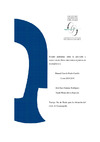Identificador persistente para citar o vincular este elemento:
https://accedacris.ulpgc.es/jspui/handle/10553/70218
| Campo DC | Valor | idioma |
|---|---|---|
| dc.contributor.advisor | Santana Rodríguez, José Juan | es |
| dc.contributor.advisor | Montesdeoca Esponda, Sarah | es |
| dc.contributor.author | Pardo Castillo, Manuel Camilo | es |
| dc.date.accessioned | 2020-02-10T10:11:37Z | - |
| dc.date.available | 2020-02-10T10:11:37Z | - |
| dc.date.issued | 2020 | - |
| dc.identifier.uri | https://accedacris.ulpgc.es/handle/10553/70218 | - |
| dc.description.abstract | Organic ultraviolet filter compounds have begun to gain interest by increasing their use in personal care products in the population. In addition, harmful effects have begun to be seen in aquatic ecosystems at high in different concentrations in the water. For its part, plastics are a problem that has been increasing in recent years due to the excessive use of plastic in people's daily lives and the mishandling of it at the time of its final destination as waste. This plastic when fractionated is known as microplastics (MP) and its presence in the marine environment is increasing. Depending on the material of manufacture it has the capacity to accumulate compounds on the surface or in its interior thus increasing the damage caused to ecosystems and aquatic fauna. For this reason, it is important to establish processes to understand the adsorption capacity of compounds such as solar filters on microplastics and to carry out processes to recover them by means of techniques such as ultrasound and their determination as ultra high performance liquid chromatography with mass spectrometry in tandem (UHPLC-MS/MS). Five solar filters were determined on MP: 4-Methilbenzilidene Camphor (4-MBC), Homosalate (HMS), Benzophenone-3 (BP3), Octocrylene (OC) e Isoamyl p-methoxycinnamate o IMC by UHPLC MS/MS in MiliQ and sea water with low recovery percentages (less than 15% in all compounds). Further testing with different extraction times, solvent types and pH variations during extraction should be performed. | en_US |
| dc.language | spa | en_US |
| dc.subject | 2301 química analítica | en_US |
| dc.subject | 250811 Calidad de las aguas | en_US |
| dc.subject.other | Adsorption | es |
| dc.subject.other | Extraction | es |
| dc.subject.other | Solar filter | es |
| dc.subject.other | Mass spectrometry. | es |
| dc.title | Estudio preliminar sobre la adsorción y extracción de filtros ultravioleta orgánicos en microplásticos | es |
| dc.type | info:eu-repo/semantics/masterThesis | en_US |
| dc.type | MasterThesis | en_US |
| dc.contributor.departamento | Departamento de Química | es |
| dc.contributor.facultad | Facultad de Ciencias del Mar | en_US |
| dc.investigacion | Ciencias | en_US |
| dc.type2 | Trabajo final de máster | en_US |
| dc.description.notas | Máster en Oceanografía ; 2018-2019 | en_US |
| dc.utils.revision | Sí | en_US |
| dc.identifier.matricula | TFT-53329 | es |
| dc.identifier.ulpgc | Sí | en_US |
| dc.contributor.buulpgc | BU-BAS | es |
| dc.contributor.titulacion | Máster Universitario en Oceanografía por la Universidad de Cádiz, la Universidad de Las Palmas de Gran Canaria y la Universidad de Vigo | es |
| item.grantfulltext | open | - |
| item.fulltext | Con texto completo | - |
| crisitem.advisor.dept | GIR IUNAT: Análisis Químico Medioambiental | - |
| crisitem.advisor.dept | IU de Estudios Ambientales y Recursos Naturales | - |
| crisitem.advisor.dept | Departamento de Química | - |
| crisitem.advisor.dept | GIR IUNAT: Análisis Químico Medioambiental | - |
| crisitem.advisor.dept | IU de Estudios Ambientales y Recursos Naturales | - |
| crisitem.advisor.dept | Departamento de Química | - |
| Colección: | Trabajo final de máster | |
Visitas
406
actualizado el 31-oct-2024
Descargas
144
actualizado el 31-oct-2024
Google ScholarTM
Verifica
Comparte
Exporta metadatos
Los elementos en ULPGC accedaCRIS están protegidos por derechos de autor con todos los derechos reservados, a menos que se indique lo contrario.
